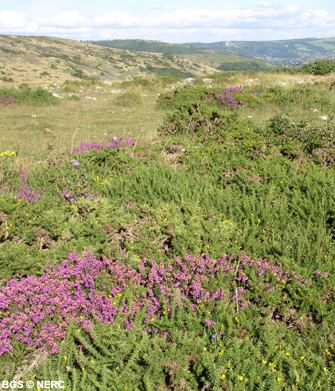
Special Mendip habitats
Introduction | Limestone cliffs, crags, caves and screes | Limestone heath | Old lead workings | Ash-lime woodland
Limestone heath

Limestone heath is a term used to describe the heathland vegetation that grows on leached mineral soils or superficial deposits (e.g. loess) overlying limestone bedrock. It develops mainly on plateau sites and north-facing slopes where rain has leached the carbonate from the surface soil, rendering it acidic enough to support typical calcifugous (lime-hating) species like ling, western gorse and tormentil.
Stands of limestone heath are usually quite small, and they often occur in close juxtaposition with rich limestone grassland, thereby presenting an intriguing small-scale mosaic of calcifugous and calcicolous plants apparently growing together. A good example of limestone heath can be seen close to the car park at Blackmoor Reserve and on Crook Peak.
- Home
- Overview maps
- Locality
areas
- Cheddar Gorge
- Charterhouse
- Blackdown
- Burrington Combe
- Shipham & Rowberrow
- Crook Peak & Axbridge
- Banwell to Churchill
- Priddy
- Harptree & Smitham Hill
- Draycott & Westbury-sub-Mendip
- Wookey Hole & Ebbor Gorge
- Wells
- Great Elm & Vallis Vale
- Mells & the Wadbury Valley
- The Vobster area
- The Whatley area
- Torr Works & Asham Wood
- Beacon Hill
- Stoke St Michael & Oakhill
- Holwell & Nunney
- Shepton Mallet & Maesbury
- Gurney Slade & Emborough
- The Nettlebridge valley
- Geology
- Minerals and mines
- Quarrying
- Caves and karst
- Biodiversity
- Detailed site information
- Acknowledgements
- External links
- Search
- Site map